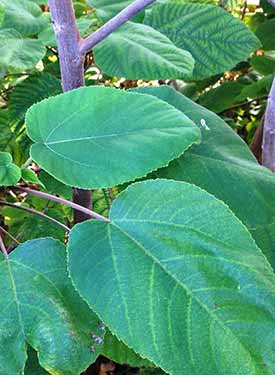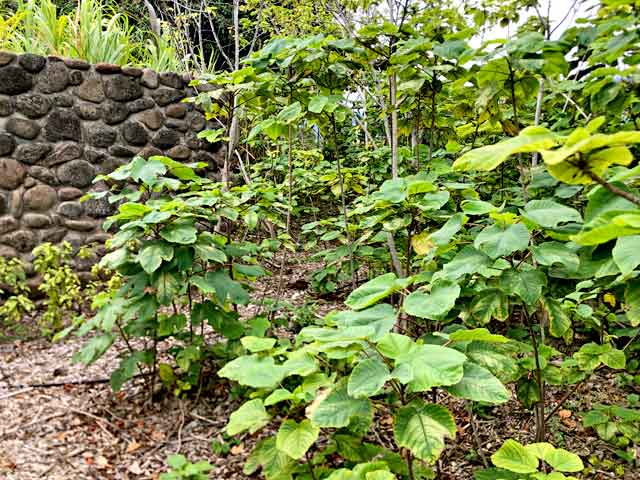Wauke (Broussonetia papyrifera)
Hawaiian name: Wauke
Botanical name: Broussonetia papyrifera
Family: Moraceae (Mulberry Family)
Status: Polynesian-introduced
Where found: Maui, Moloka'i, lana'i, Hawai'i, O'ahu & Kaua'i
Water/Light: Wet, with full to partial sunlight
Elevation range: 45 to 2,250 feet
Height: Up to 30 feet
From Work Done by Whit Germano to Catalog Native Hawaiian Plants
MNBG

Notes: The inner bark of wauke was the material used to make kapa, the cloth early Hawaiians used for clothing and bedding. Wauke fibers were soaked, scraped, and beaten in an intensive preparing process done mostly by women. The quality of Hawaiian kapa cloth is respected, warm, water resistant, long lasting, washable, soft, moth-proof, flexible and white. There were a great abundance of wauke plants throughout Hawai`i (prior to the introduction of foreign fabrics), but now this once cherished plant is rarely noticed.

‘Ōlelo Noeau [M. K. PUKUI]: He kukāhi au, he wauke no Kūloli.
Translation: I stand alone, for I am a wauke plant of Kūloli.
Meaning: A boast saying, “Like the lone wauke plant of Kūloli, I stand alone in my battles.” At Kūloli, in Kona, grew a lone wauke plant around which none other grew.
A Few Native Hawaiian Plants from the MNBG Collection
- ‘A‘ali‘i (Dodonaea viscosa)
- Alahe'e (Psydrax odorata)
- ‘Ānapanapa (Colubrina asiatica)
- Hala (Pandanus tectorius)
- Hala pepe (Dracaena auwahiensis)
- Hau (Hibiscus tileaceus)
- Hō‘awa (Pittosporum glabrum)
- Hō‘awa (Pittosporum hosmeri)
- ‘Iliahi (Santalum haleakalae)
- ʻIlima papa (Sida fallax)
- Kalo (Taro), Colocasia esculenta)
- Kamani (Callophyllum inophyllum)
- Koa (Acacia koa)
- Koai‘a (Acacia koaia)
- Koki‘a, Hau hele ‘ula (Kokia drynarioides)
- Koki‘o ke‘o ke‘o (Hibiscus arnottianus subsp. arnottianus)
- Koki‘o ke‘oke‘o (Hibiscus arnottianus subsp. immaculatus)
- Koki‘o ‘ula‘ula (Hibiscus kokio ssp. kokio)
- Koki‘o ‘ula‘ula (Hibiscus kokio ssp. saintjohnnianus)
- Koki‘o ke‘o ke‘o (Hibiscus waimeae ssp. waimeae)
- Kou (Cordia subcordata)
- Kukui (Aleurites moluccana)
- Loulu lelo (Pritchardia hillebrandii)
- Loulu (Pritchardia remota)
- Maʻo (Gossypium tomentosum)
- Ma‘o hau hele (Hibiscus brackenridgei)
- Māmaki (Pipturus albidus)
- Mau‘u lā‘ili (Sisyrinchium acre)
- Milo (Thespesia populnea)
- Naio (Myoporum sandwicense)
- Nānū (Gardenia brighamii)
- Ōhai (Sesbania tomentosa)
- ʻŌhiʻa ʻai (Syzygium malaccense)
- ‘Ōhia lehua (Metrosideros polymorpha)
- Pōhinahina (Vitex rotundifolia)
- Pōkalakala (Polyscias racemosa)
- ‘Uala (Sweet Potato)
- ‘Uki ‘uki (Dianella sandwicensis)
- ʻUlu cv. ‘Maʻafala’(Artocarpus altilis)
- Wauke (Broussonetia papyrifera)
- Wiliwili (Erythrina sandwicensis)

